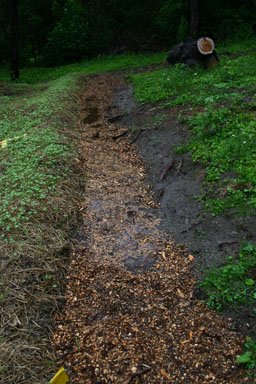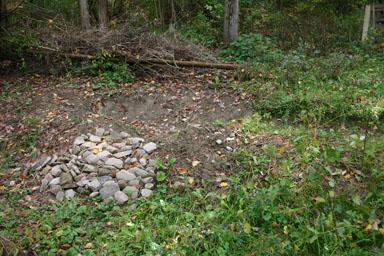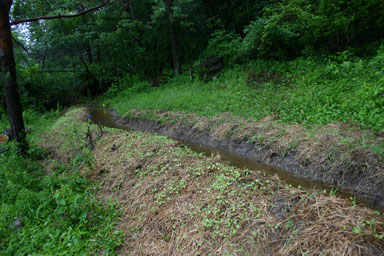December 9, 2006
Digging
While the sudden burst of plant growth in my backyard was a change, especially since so much less of it was grass, the permanent work we did this summer was mostly digging. Some of that was digging to plant trees and bushes, but the bulk of it was changing drainage patterns in the backyard.
In the past, water came rolling down Mount Pleasant, and sometimes turned the backyard into a pond an inch deep that concentrated near the bottom of the yard into a deeper stream. (See here to get an idea; that wasn't even taken near the peak.) It's meant a very wet basement at times, and all that water contributed very little as it passed by, except for some erosion. I'd built a little ditch to divert some of it, and there was an underground drain system, but neither worked very well or put the water where we wanted it.
One of this year's key projects was to change this, keeping the water around for plants to use while reducing erosion and creating happy homes for future plants. A few years ago, my neighbor had used a backhoe in his yard over the course of the summer, but we used shovels and (as you may remember) plowhorses for a day. (I didn't do nearly enough of the shoveling myself; Josh Dolan and a few of his friends provided most of this labor.)
What was once a sloping backyard is now interrupted with swales - ditches with berms on their dowhill side - and terraces. A huge swale stretches across most of the top edge of the back yard, catching the main flow of water where it comes down the hill. Other berms further down the hill catch and redirect water as well, though hopefully they won't have nearly as much water really flowing in. Most of the swales are filled with wood chips, and also act as paths when they aren't flooded.

Middle swale, partly filled with water and woodchips.
Most of the trees cut down earlier in the year found new use in berms and terrace edges, and those that remain will likely find that use next year. Also, a lot of the rocks turned up in plowing found use in erosion control.
Part of the fun of a project like this is that laying out and building the swale is only part of the work. Testing it, watching it, and modifying it is also critical to building an effective system. Water here comes in huge volumes occasionally, and we still haven't had a snowmelt for a real test. June's storms were enough to help us find some gaps in the system, especially on the eastern end of the back swale, where water rolled over the top and started some erosion until it was caught by the next swale down.
Josh fixed this by building with it, fixing the swale but preparing it to tolerate future erosion better. If the swale overflows - something that's always possible at this scale - then the water can go to the next swale down without creating new problems.

Back swale, modified to slow overflow water.
Another nice touch Josh added is a bar across the top swale that should keep the area nearest the water inflow wetter, while letting it overflow easily into the rest of the swale when necessary. It'll be a small pond, but it should be a nice place for some wildlife that we wouldn't get elsewhere in the garden.
If you're gardening in a flat area, this work may not be as important to you, but even there it may help keep water around. In any case, I'm very glad we started with this, and it should make going forward much easier.
If you'd like to see more, I've posted a gallery of photos showing construction, runoff, and revisions.
Posted by simon at December 9, 2006 12:45 PM in my house , permacultureNote on photos
